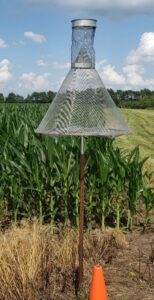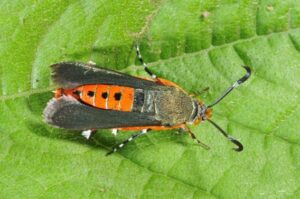There are many traps available to help with monitoring insect populations. As you prepare for the 2024 growing season, I wanted to review some of them in case you want to implement trapping on your farm to help improve your pest management programs.
Trap Design
Traps come in a variety of shapes, sizes, and colors. Much research has gone into the design, taking advantage of the behaviors of each insect that the trap is created to capture. Some insects are attracted to specific colors, others various shapes, and some move in a predictable manner in response to certain stimuli. For example, pests like aphids, thrips, and whiteflies are attracted to the color yellow, hence the reason why many sticky cards are yellow. Pollinators are also attracted to yellow because of the occurrence of this color in plant flowers. Therefore, you can unintentionally catch pollinators in yellow traps. Broadly, moths fly in an upward direction when they encounter stimuli or navigate based on the moonlight. Therefore, cone-shaped traps are often used to collect moths. In orchards, red balls coated in pheromones and a sticky substance are used to monitor pests that attack developing fruits; the trap mimics the shape and color of the fruit. The three main trap types used to monitor vegetable insects include bucket traps (Figure 1), delta traps (Figure 2), and cone traps (Figure 3).
The bucket-style trap comes in various colors and holds a pheromone lure in the basket below the lid. Insects fall inside the bucket and can not get out. A kill strip is often placed inside the bucket, but this can be omitted or replaced with soapy water if you are an organic grower.
This trap is coated on the inside with a sticky substance that traps the insect to the surface. A pheromone lure is often placed on the sticky surface inside the trap, and the trap is suspended in the crop canopy. The trap is often white but can come in other colors depending on the target insect.
The trap pictured above is called a Hartstack trap. Another version of a cone trap can be seen below. The pheromone lure is attached at the wide base of the cone. A collection chamber at the top of the trap can be removed and emptied.
The benefits of trapping are numerous. Depending on the pest-crop complex, traps can be used to monitor the emergence of a pest population so that you may alter your planting, usually after the emergence, to avoid damage to young seedlings/transplants. Traps can also be used to time the application of pesticides or the release of natural enemies. By using traps as a monitoring tool, you can detect when a pest population is active on the landscape and present in your crop. It is the best practice to monitor a trap first, then when the pest is detected, scout the crop to confirm its presence. You can then make applications of pesticides or release natural enemies at a time to get the most bang for your buck. Below, I will provide a few examples of pest insects and traps that are available to integrate into your IPM program.
Corn earworm
The corn earworm, Helicoverpa zea, is a common pest of sweet corn. To monitor this pest, we pair a cone-shaped trap with a pheromone lure that smells like the female moth. When male moths are present on the landscape and looking for a mate, they fly around ‘sniffing’ the air for a female. The trap is designed to capture males, which we can use to indicate that the population is present in the crop and looking to mate and lay eggs. It is the egg laying on the silk of the developing corn that causes the damage. Therefore, we can monitor the stage of the crop (i.e., is silk present) and the population of the moths (how many we catch in our traps) to time insecticide applications more effectively. There is a statewide trapping network established for this pest, which can be found here: https://extension.entm.purdue.edu/veg/cornearworm/.
You can use the trapping location nearest your farm to monitor the population or erect a trap on your farm. Spray applications should consider three factors:
- Trap catches.
- Presence of silk in the crop.
- Stage of surrounding field corn.
More information can be found on the website above.
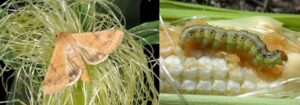
Figure 4. Corn earworm adult (left) that will be captured in the trap and larvae (right) which cause damage to the crop (Photos by John Obermeyer).
Squash vine borer
The clearwing moth, Melittia cucurbitae, can be devastating in cucurbit production, especially in urban production systems. This moth typically has two generations per year in our region. The damage they inflict on the crop occurs when the females deposit their eggs at the base of the crop. The eggs hatch and the caterpillars bore into the stem. The most effective way to manage this pest is to target insecticide applications at the time of egg hatch so that the larvae consume a lethal dose as they take their first few bites before boring into the stem. The best way to monitor this is to use a pheromone-baited trap, much like the abovementioned CEW. Again, we have a lure that smells like the female moths. When the adult males are present on the landscape and looking for a mate, they can be lured into a trap using the scent of the female. You can time your pesticide application to a few days after you begin catching adult male moths, ensuring good coverage at the base of the plant. For this pest there is also a statewide trapping network established, which can be found here: https://extension.entm.purdue.edu/veg/squash-vine-borer/.
This year, we will be using a delta trap and, through a collaboration with the Great Lakes Urban Ag IPM Working group, expand our trapping network across the Midwest. We will use sticky traps to ease reporting. However, a better design is a cone trap that can also be used for corn earworms (Figure 5). There are other species of clear-winged moths that you may catch in the traps, including peach tree borer and grape root borer. Specific pheromones for these species are available, but sometimes they can be attracted to the smell of their relatives (i.e., other clearwing moths).
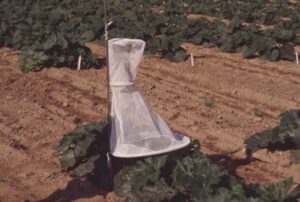
Figure 5. Scentry Heliothis trap for squash vine borer trap (Photo by Alan Eaton, University of New Hampshire).
Tomato pinworm
This is a ‘new’ pest (Figure 7) in Indiana and is becoming a problem, specifically in tomatoes cultivated in high tunnels. This microlepidopteran pest is problematic because the adults are very small and difficult to detect, and the larvae are leaf miners or fruit borers, meaning they are protected within the plant tissue for much of their lifecycle. You can purchase tomato pinworm lures that are placed inside a delta trap to monitor this pest in your crop. Place them around the perimeter and check weekly. If you detect adult moths, then scout the crop, beginning with the leaves and stems, to look for damage. If you are interested in joining a state-wide monitoring network for this pest in 2024, please contact me directly.
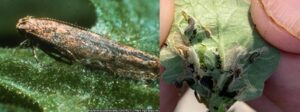
Figure 7. Tomato pinworm adult that will be captured in the traps (left; photo by GNORLY) and larvae damaging the plant (right; photo by Dan Egel).
There are a variety of other traps available for monitoring specific pests, many of which are common for orchard crops. If you have a particular pest on your farm that you struggle to detect or manage, I recommend you look into options that are available for pheromone trapping/monitoring.
FAQs
Will pheromone-baited traps lure a pest into my crop, making it more of a problem?
No, in most instances, these traps only work within a few feet of the monitoring station and, therefore, will only pull in local populations. That is, those that are already on your farm and foraging for a suitable crop. The only exception is Japanese beetles. I DO NOT recommend using these traps. This pest is so widespread and mobile we do see that placing a trap on your farm/in your yard can increase the pest pressure, pulling in your neighbor’s beetles. They are great for research when we need to catch hundreds, but they are not recommended as a management/monitoring tool.
How often should I check my trap?
I recommend checking twice a week, if possible, especially when your crop is in a vulnerable stage (seedling emergence or after transplant, or silking for corn production). Empty/replace the traps as you begin to catch the pest. This will make it easier for you to distinguish new catches from old.
How often do I have to change the lure?
This depends on the lure and the manufacturer, but it is an important detail to pay attention to. If the lure is in the field beyond the recommended time, the scent declines, and it is no longer effectively pulling in the target pest.
Where do I get trapping supplies?
There are a variety of suppliers, so check with whom you have already purchased your pest management tools from. If you are looking for others, check out Great Lakes IPM, Gemplers, or other agricultural supply retailers.
If you are interested in participating in any of the state-wide trapping networks or would like to see a new pest added, please email me at lingwell@purdue.edu or call (765)494-6167.
A version of this article was previously published in the Vegetable Crops Hotline Newsletter.
Insect Traps as a Monitoring Tool https://vegcropshotline.org/article/insects-traps-as-a-monitoring-tool/
Consider Reading These Related Articles
Looking for Squash Vine Borer (SVB) Trapping Collaborators https://vegcropshotline.org/article/looking-for-squash-vine-borer-svb-trapping-collaborators/
Presence of Tomato Pinworm on High Tunnel Tomato in Indiana https://vegcropshotline.org/article/presence-of-tomato-pinworm-on-high-tunnel-tomato-in-indiana/
Pheromones and Pheromone Traps https://vegcropshotline.org/article/pheromones-and-pheromone-traps-4/
DIY Traps for Cucumber Beetle Management https://vegcropshotline.org/article/diy-traps-for-striped-cucumber-beetle-management/


